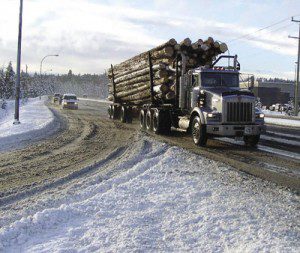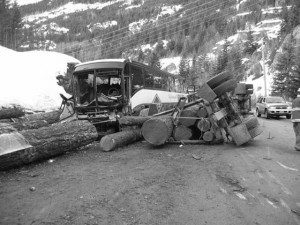 For best printing results, use the pdf version attached at the bottom of this article on BC Forest Safety website.
For best printing results, use the pdf version attached at the bottom of this article on BC Forest Safety website.
1. Do your pre-trip – all of it. There are enough things that will surprise you during the day without your truck being one of them. Know your equipment – intimately. Be confident it will perform as you expect it to. Before winter is over, you are likely to need every one of those tires to give you 100% traction – there’s no room for worn-out, mismatched or under-inflated tires. And you’ll need each one of your brakes working – together. When those moments occur, there is no margin for “too tight”, “too loose”, or “not quite sure”.
2. Get the pre-work information you need. Going on a new haul tomorrow? Talk to your supervisor and find out where you are headed, what sort of terrain it’s in, what usual and unusual hazards you should expect to encounter. Supervisor doesn’t know? Check with the dispatcher. Or find another trucker on that haul and get the skinny from him. Are you going on the same haul as yesterday? Ask yourself: What is likely to be different? New loader man? New rotation? New traffic coming on mainline at 37 km? Change in weather overnight?
3. Have a plan. Thinking your day all the way through – including your safe arrival back home – will help you do exactly that. Before each game, Sidney Crosby thinks carefully about this game, his opponents, his match-ups and what he and his team will have to do to be successful. As you enjoy breakfast, think about our day. What will be the same? What will be different? 2 trips or 3? Where will I meet the school bus? CVSE will be out today, so expect a bit of a delay on Highway 97. Tom is loading first and he sets a gentle pace, so I’ll have a couple of minutes to pullover at the top of Morehead and make that call about Billy’s hockey practice. Sure, you’ll experience a few curves that require you to adjust your plan, but if you have already thought about what those curves might be, you have them at least half-solved.
4. Pay attention to the weather. Check tomorrow’s weather forecast the night before. 8 cm of new snow and -2 degrees and warming to +3 early afternoon? This could be a stressful day. But knowing what you are likely to encounter helps manage that stress. You can reduce that stress by leaving a few minutes early. You have time to drive at a casual pace, and according to road conditions. Today is not the day to worry about making your cycle time. Even if the forecaster is wrong and the roads are fine, the worst that can happen is that you are under the loader a few minutes early.
5. Pay attention to your outside thermometer. Don’t have one? Get one. Sure the traction is fine at +5 degrees (i.e. the pavement is bare) and starts getting better below -5 degrees. But when temperatures hover a few degrees either side of zero, conditions get tricky. With inversions and unpredictable winter weather patterns, temperatures change dramatically over a few hundred metres. That means your traction – as well as that of the goof in the SUV with all-season tires – can change very quickly.
 6. Keep an eye on the glaze. With your headlights on, scan the road ahead of you and watch for that tell-tale shine in the tracks ahead – it’s slippery out there! Can’t quite see it in your lane? Briefly glance at the road in the headlights of on-coming traffic. If it looks slick in their lane, it’s probably equally slick in your lane.
6. Keep an eye on the glaze. With your headlights on, scan the road ahead of you and watch for that tell-tale shine in the tracks ahead – it’s slippery out there! Can’t quite see it in your lane? Briefly glance at the road in the headlights of on-coming traffic. If it looks slick in their lane, it’s probably equally slick in your lane.
7. Set your eyes to scan. Scan ahead on the road as far as you can. Re-direct your gaze to the road immediately in front of you. Check out half way between you and the next corner. Mirrors. Dashboard. Road pattern. Left ditch. Right ditch. Repeat often, with a little variability to keep it fresh.
8. Have a backup plan. What’s my escape route? That little Mazda coming over yonder hill looks a little skittish – what will I do if she gets out of control? That ditch on the right looks too deep to survive, so I had better slack off and make plans for a quick stop, if necessary. Think ahead – what will I do if…..?
9. Use the buddy system. Rookie or seasoned veteran, we all appreciate knowing about a hazard before it becomes a surprise. If you see something that wasn’t there yesterday, let your co-workers know. If you know there’s a new gal on your haul, tell her about that nasty frost heave at 17 km, even though everyone else knows about it. If she doesn’t know about it and it results in a screw-up, it could ruin your day too. We’re all in this together….
10. Ditch the distractions. Next time you’re sharing an ‘intimate moment’, ask your partner if it’s OK that you text your boss to schedule an oil change on Friday. Let me know how that goes for you. Hauling logs is no different – both hands on the wheel, focus on the task at hand, leave the gadgets alone.
And Remember…
- Use all the tools you can to help your aid in your visibility.
- A clean windshield – inside and out.
- Carry extra windshield washer fluid.
- Sun glasses. Maybe even 2 sets: one for bright sunny days, and another set for those low light, poor visibility conditions. Less eye strain = lower driver fatigue.
- Find a headlight combination that works. 10 million candle-power doesn’t help you in a blinding snowstorm, they simply increase the glare reflected back to your eyes. Some folks like an amber fog light to soften the glare of driving snow. Maybe point one a little toward the right hand ditch – you might not be able to see the center-line, but if you can use the snow bank or ditch line as a steady reference, you are miles ahead. Plus you can see that moose coming out of the ditch a half-second earlier.
- Allow for stupid. Other folks out on the trail might not be the skilled professional you are; they don’t have winter tires, didn’t scrape the windshield, they’re driving too fast for conditions and trying to find the next Highway Cam on their Blackberry. AND they are out on the road with you – fantastic! Practice your best driving etiquette. Give them some space. Let ‘em go ahead. Are they endangering the lives of others on the trail? Let the RCMP know. But keep them out of your safe trucking zone.
Visit BC Forest Safety website for the PDF download.
Discussion
No comments yet.